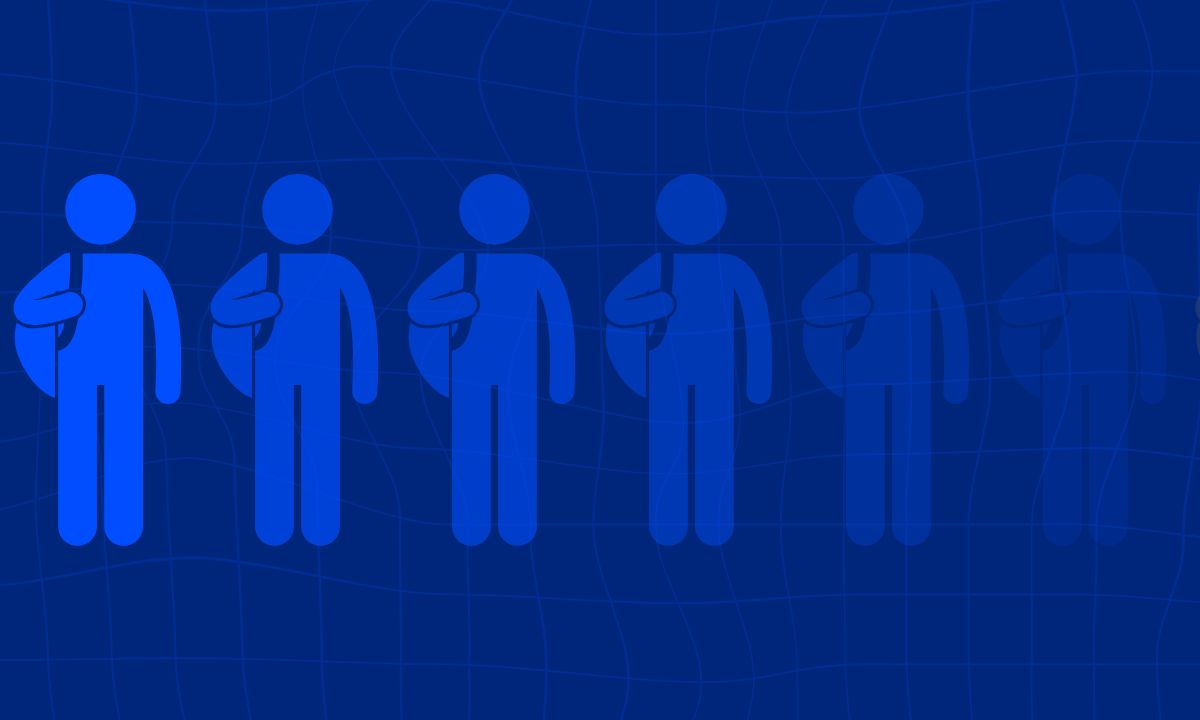Public School Enrollment Is Declining — But Not Everywhere, or for All Students
Moon: A new analysis shows these trends vary widely by race, grade level, geography, even schools. What that could mean for the future.

Get stories like this delivered straight to your inbox. Sign up for The 74 Newsletter
A version of this essay appeared on the FutureEd blog.
Between fall 2019 and fall 2023, public school enrollment fell from 50.8 million to 49.5 million, a loss of more than 1.2 million students, or 2.5%. The pandemic accelerated that decline, but enrollment was already falling in some grades and communities before COVID, and that trend is expected to continue: The National Center for Education Statistics (NCES) projects overall enrollment will fall below 47 million by 2031.
Yet a FutureEd analysis based on data from NCES, the Center for Disease Control and Prevention and other sources, finds that enrollment trends vary widely by race, grade level, geography and schools. That variation offers important insight into how the education landscape is shifting, where the challenges are most acute and what it means for the future of the public school system.
When COVID struck and public schools switched to virtual learning, some families began educating their children at home; others opted for private schools, many of which resumed in-person learning sooner than public schools.
Though many families eventually returned, by fall 2022, an estimated 3.4% of American children were homeschooled, compared with 2.8% in fall 2019 — and advocates say the number continues to rise. Private school enrollment also grew, reaching roughly 7 million in 2021, an estimated 22% increase over pre-pandemic levels. Newly expanded school choice policies are likely to accelerate that shift: Sixteen states offer or intend to offer public funding for private school tuition to any student in the state. While these programs haven’t yet triggered a mass public school exodus, they are likely to reshape some family preferences and expand the supply of private alternatives.
Still, family choices aren’t the sole or even primary driver of the decline. The U.S. birthrate has fallen steadily for more than a decade and is now —at just under 1.6 — the lowest in history. Between 2010 and 2020, the number of children under 5 fell by 1.8 million nationwide, from 20.2 million to 18.4 million. That shrinking pipeline is now reaching classrooms.
Historically, immigration has helped offset declining birth rates, but that may not be enough to sustain enrollment. Recent immigration crackdowns could further reduce student numbers.
Domestic migration is also reshaping enrollment patterns. High housing costs and taxes are driving families from urban areas and high-cost states like California. As a result, some regions are experiencing much steeper enrollment losses than others, while others are growing.
The sharpest declines are seen among the youngest students. Between fall 2019 and 2023, kindergarten enrollment fell by 215,000 students — nearly 6%. Elementary schools overall lost about 865,000 students (4%), while middle school enrollment (grades 6–8) declined by nearly 700,000 (6%). The largest drop, 7%, was seen in sixth grade. High school enrollment increased slightly, rising 2%, or roughly 345,000 students.
The trends also vary by race and ethnicity. White students account for the largest share of the overall decline, a loss of nearly 2 million kids between fall 2019 and 2023 — an 8% drop. Black enrollment fell by about 250,000 students, or 3%. These decreases pre-dated the pandemic but accelerated afterward. As of fall 2023, white student enrollment is down 13% from its 2014 level.
Meanwhile, Hispanic and Asian enrollment — long drivers of public school growth — continued to grow, but more slowly. Public schools added roughly 540,000 Hispanic students between fall 2019 and 2023 (a 4% increase), and about 72,000 Asian students (3%). In the five years before the pandemic, both groups were growing at closer to 8% to 9%. These increases are no longer large enough to offset losses among white and Black students.
Enrollment declined in 41 states between fall 2019 and 2023, ranging from 0.3% in Louisiana to 6.5% in Hawaii. Thirteen states lost at least 5% of their students. California saw the largest decrease: 325,000 students (5%). In total, 29 states had fewer public school students in fall 2023 than they did in 2014 — and 23 states are projected to lose at least another 5% by 2030. West Virginia is expected to see the steepest proportional decline, at 18% (45,000 students), and California projected to lose the most students at 500,000 (8%).
At the same time, 10 states, mostly in the South and Midwest, with lower overall tax burdens, saw enrollment growth between fall 2019 and 2023.
Within states, urban districts, which had been growing before the pandemic, saw the steepest post-pandemic declines, losing some 675,000 students, or about 4%. Rural, suburban and town-based districts also lost students, though these decreases were more modest in comparison, around 1% to 2%.
In California, for example, urban districts accounted for much of the state’s overall decline, losing 180,000 students between fall 2019 and 2023. Los Angeles Unified School District lost the most students, 63,000 (13%), while Santa Ana Unified School District experienced a 17% decline (about 7,500).
Even within districts, the impact varies. In Los Angeles Unified, high-poverty schools lost an average of 15% of their enrollment, versus a 10% decline at schools with fewer low-income students. And nationwide, public charter school enrollment has grown from 2.7 million in fall 2014 to 3.4 million in fall 2019 and 3.7 million in fall 2022, the most recent data available.
So what are the consequences?
In most states, public school funding is directly tied to enrollment. When students leave, or never enroll, schools lose per-pupil state dollars, which typically account for around 45% of their budgets. Federal COVID relief funds temporarily masked the strain, but with that money now expired, many schools are feeling the pressure.
As budgets tighten, students often bear the consequences. Under-resourced schools may cut arts programs, electives and extracurriculars, or eliminate counselors, librarians and mental health professionals. With fewer students, schools also need fewer teachers, prompting layoffs that ripple through schools and local economies. And when enrollment drops sharply, course offerings inevitably shrink. Schools can’t sustain multiple Advanced Placement classes, foreign language courses or sports teams if buildings are only half full.
Eventually, under-enrolled schools may be closed, which can disrupt students, displace staff and erode community life. Between 2019 and 2024, for example, West Virginia, where enrollment is down 12% from 2014, shut 53 of its more than 600 schools due to declining enrollment. In rural areas, closures can be particularly disruptive; shuttering a small town’s only school might mean the next nearest option is an hour’s bus ride away. In all cases, students must be reassigned, which brings its own challenges and added costs to the neighboring schools. And when a school closes, it’s not just students who are affected — teachers, janitors, cafeteria workers and other staff often lose their jobs, deepening the impact on the broader community.
Today’s enrollment declines don’t seem like a temporary disruption, and districts are going to have to deal with this new reality. That doesn’t always mean closing schools, but ignoring the inefficiencies of under-enrolled buildings isn’t sustainable. Georgetown University’s EdunomicsLab has identified ways of keeping small schools open, such as sharing staff across buildings or leasing out unused space.
There is no one-size-fits-all solution. But as enrollment patterns continue to change, school districts will need to respond by balancing fiscal responsibility with community needs, all while ensuring that fewer students doesn’t mean fewer opportunities.
Get stories like these delivered straight to your inbox. Sign up for The 74 Newsletter

;)